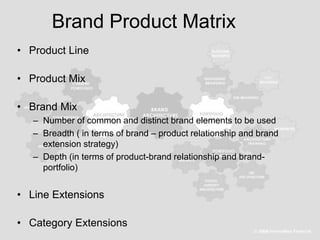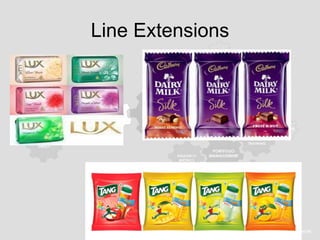mkt465_ch11 (2).ppt
- 2. Brand Architecture • The branding strategy of the firm which tells marketers which brand names, logos, symbols apply to which new and existing products. • Umbrella, family or corporate branding (branded house) • Individual brands (house of brands)
- 3. The Role of Architecture • Clarify-brand awareness – Improve customer understanding and communicate similarity and differences between individual products • Improve-brand image – Maximise transfer of equity to/from the brand to individual products to improve trial and repeat purchase
- 4. Brand Product Matrix 1 2 3 …..n A B C …. Products Brands Brand Product Relationship (brand line) Product Brand Relationship (product line)
- 5. Unilever Soap Shampoo Detergent Lotion Lux – sizes, form, flavours and color 20- depth Lux Wheel Dove Dove Dove Vaseline Palmolive Cinthol Line width Line length Toiletries Spices Pharmaceuticals Inconsistent line consistent line
- 6. Brand Product Matrix • Product Line • Product Mix • Brand Mix – Number of common and distinct brand elements to be used – Breadth ( in terms of brand – product relationship and brand extension strategy) – Depth (in terms of product-brand relationship and brand- portfolio) • Line Extensions • Category Extensions
- 9. Category Factors Threat of new entrants Bargaining power of buyers Bargaining power of sellers Current Category Rivalry Pressures from substitutes Category Capacity Environmental Factors Technological Political Economic Regulatory Social Aggregate Market Factors Market Size Market Growth Stage in PLC Sales cyclicity Seasonality Profits Brand Portfolio Breadth of a Product Mix
- 10. Depth of a brand • Different brands in the same product class • To pursue Multiple Market Segments • To increase shelf presence and retailer dependence • Variety to customers • Internal Competition • Economies of scale in advertising, sales, merchandising and distribution
- 11. Other Special Roles of brand in a portfolio • Tap into untapped segment • Serve as flanker and protect flagship brand • Serve as cashcow and be milked for profits • Low end entry level product – customer acquisition • High end prestige product
- 12. JW Marriott Hotel chain 5 star Big city – 1 Marriott Marriott courtyard Marriott inn Marriott resorts $$$$ $$$ $$$$$ Upward line stretching downward line stretching Bothways line stretching
- 13. • Increase shelf presence and visibility • Attract more variety seeking customers • Increase internal competition • Yield economies of scale Other Special Roles of brand in a portfolio
- 14. Brand Hierarchy • Kapferer’s Branding System – Product Brand (Ariel, tide and Dash by P & G) – Line brand.. Across different products (Chevrolet: GM) – Range Brand or Umbrella brand … (maggi food range) • Other Way of classifying – Corporate brand (GM) Unilever – Family Brand (Chevrolet) Lux – Individual Brand (optra) Lux soap – Modifier (GLX) variations of the lux soap
- 15. Corporate Branding • A corporate brand is distinct from a product brand because it can encompass a whole new set of associations • It’s a powerful means to express the company philosophy in a way that is not tied to the product or the service
- 17. Examples of Corporate Branding
- 18. Examples of Corporate Branding
- 19. Family Brands • Distinct family brands creates a special set of associations across a group of related products- instant ready to eat food • Cost of introducing a related new product is lower • Acceptance of new products is higher • However, failure of one can effect others • Marketing activities need to be closely coordinated
- 21. Individual Brand Level • Restricted Essentially to one product category, although variations are possible in terms of product form and size – E.g Lifebuoy soaps: Liquid and bars • All marketing activities can be customized to support the brand and the product • If it fails, other entities remain unharmed • However, it is expensive and complex
- 23. Modifiers • Adding a modifier can signal refinements or differences in brands, related to factors such as – Quality levels – Attributes – Functions • They show how one brand variation relates to others in the same family • They make products more understandable and relevant to customers
- 24. Modifiers
- 25. Corporate Image Dimensions • Product Related – High Quality – Innovative • People and Relationships – Customer Orientation • Values & Programs – Socially responsible – Environmentally concerned
- 26. Quality
- 27. Innovativeness
- 29. Cause Related Marketing • “Process of formulating and implementing marketing programs that are characterized by an offer from the firm to contribute a specified amount to a designated cause when customers engage in revenue- providing exchanges that satisfy both organizational and individual objectives.”
- 30. Examples As always, every cent of VIVA GLAM VI goes to the M·A·C AIDS Fund to support people living with HIV/AIDS.
- 31. Longest Running Example • Product Red is a brand licensed to partner companies such as American Express, Apple Inc., Starbucks, Converse, Motorola, Gap, Emporio Armani, Hallmark, Microsoft, and Dell. It is an initiative begun by U2 frontman Bono and Bobby Shriver of DATA to raise money for the Global Fund to Fight AIDS, Tuberculosis and Malaria
- 33. Green Marketing • Special case of cause marketing
































